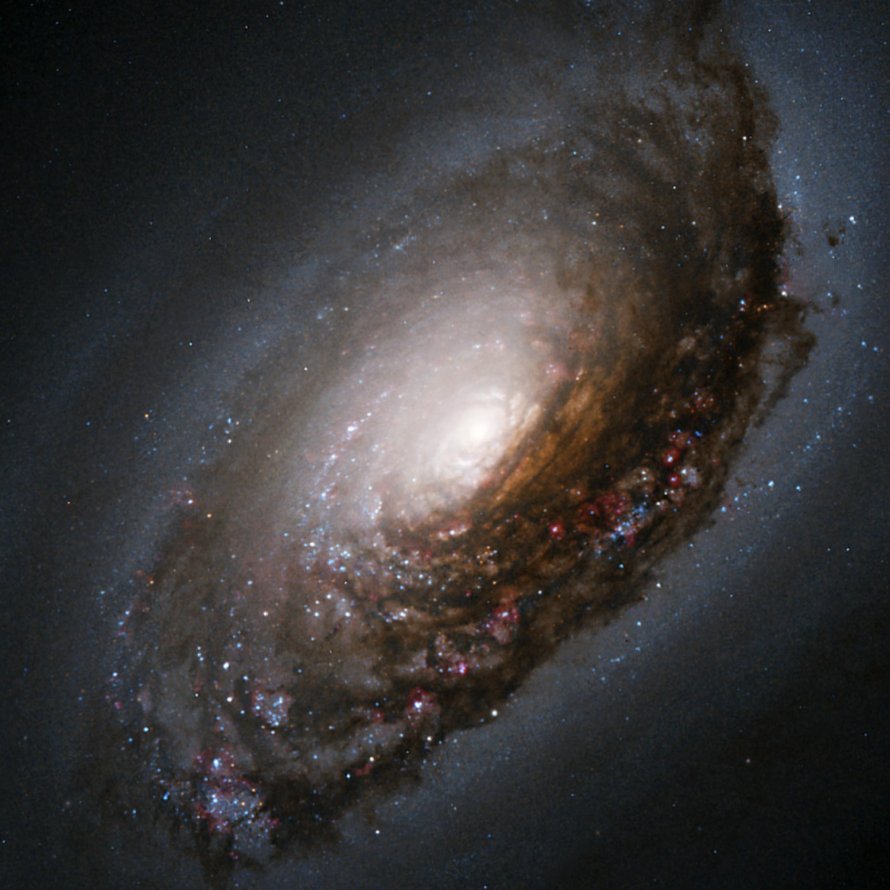M64 (NGC 4826) - Blackeye Galaxy
Messier 64 (NGC 4826), also known as the Blackeye Galaxy, is a spiral galaxy located in the constellation Coma Berenices in the CVn I Group of galaxies. M64 is 17300000 light years away from Earth.
M64 is best viewed during late spring, is magnitude 8.5, and can be viewed with binoculars. M64 is 10.7' x 5.1' in apparent size. For reference, the full moon is 30'.
Observing difficulty: Intermediate
- Name:
- Blackeye Galaxy
- Alt name:
- Sleeping Beauty Galaxy
- Type:
- spiral galaxy
- Constellation:
- Coma Berenices
- NGC or IC:
- NGC 4826
- Magnitude:
- 8.5
- Viewing:
- binoculars
- Size:
- 10.7' x 5.1'
- Distance (light years):
- 17300000 LY
- RA:
- 12h 56.7m
- Dec:
- 21 41'
- Season:
- late spring
- Galaxy group:
- CVn I Group
- Messier Marathon #:
- 47
* The naked eye can see up to magnitude ~7-8 objects under ideal dark sky conditions.
The Black Eye Galaxy
Messier 64, commonly known as the Black Eye Galaxy or the Sleeping Beauty Galaxy, is a famous spiral galaxy located in the northern constellation Coma Berenices. It was first discovered by the English astronomer Edward Pigott in 1779. The galaxy has captured the interest of astronomers and sky-watchers alike due to its prominent dark dust band in front of the galaxy's bright nucleus, which appears like a "black eye".
Characteristics
Messier 64 is a spiral galaxy, classified as type (R)SA(rs)ab in the galaxy morphological classification scheme. This indicates a spiral galaxy with a ring structure (R), a slight inner ring (rs), and moderately tightly wound spiral arms (ab). The inner structure of Messier 64 is composed of a small bar surrounded by a tightly wound spiral structure that ends in an outer, somewhat rectangular ring.
The most striking feature of Messier 64 is the dark, obscuring band of dust that absorbs light from the bright nucleus, giving the galaxy its "black eye" appearance. This feature is a result of a complex interplay of gravitational effects, possibly due to a past interaction with another galaxy.
Magnitude and Size
The Black Eye Galaxy has an apparent magnitude of about 8.5, which makes it a relatively bright galaxy. Nevertheless, it is too faint to be seen with the naked eye. Its actual size is about 9 x 5 arcminutes, which corresponds to a spatial diameter of around 51,000 light-years.
Finding and Viewing Messier 64
Finding the Black Eye Galaxy can be a rewarding challenge for amateur astronomers. It is best observed during the spring months when Coma Berenices is high in the sky. The galaxy is located near the star 35 Comae Berenices.
To find Messier 64, locate the constellation of Coma Berenices, which lies near the larger and more recognizable constellation Leo. From the star Denebola (the tail of Leo), move eastward to locate the star 35 Comae Berenices. M64 is located just a degree southeast of this star.
In a small telescope, Messier 64 will appear as a faint, elongated glow. A larger telescope will reveal the galaxy's bright core and the dark lane of dust that gives the galaxy its "Black Eye" nickname. Viewing conditions, particularly light pollution and atmospheric stability, can significantly impact the visibility of this galaxy.
Observing Messier 64 can be a delightful experience for any astronomy enthusiast, offering a glimpse into the dynamic and sometimes violent processes that shape galaxies. As always, patience and practice in locating and observing this celestial object will enhance the viewing experience.



